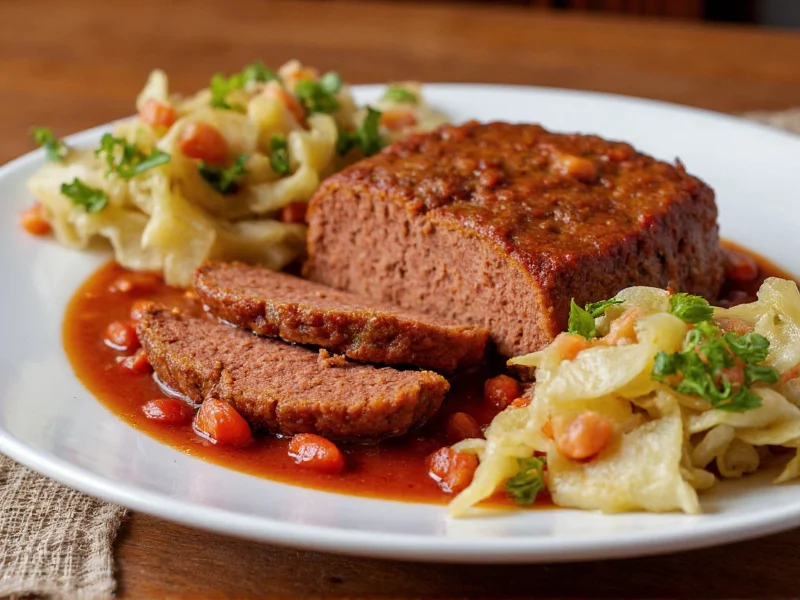When searching for the ultimate souper meatloaf experience, home cooks often struggle with dry, crumbly results that lack depth of flavor. The difference between ordinary and extraordinary meatloaf comes down to understanding the science behind ingredient ratios, moisture management, and cooking precision. This guide reveals the professional techniques that transform a humble comfort food into a showstopper worthy of any dinner table.
Why Most Meatloaf Recipes Fail
Common pitfalls plague traditional meatloaf preparations. Overmixing develops gluten in breadcrumbs, creating a dense texture. Using only lean ground beef sacrifices essential fat content needed for moisture. Incorrect oven temperatures either dry out the exterior before the center cooks or leave dangerous undercooked portions. Understanding these challenges is the first step toward perfect meatloaf every time.
Essential Components of Superior Meatloaf
| Component | Professional Recommendation | Common Mistake |
|---|---|---|
| Meat Blend | 50% beef (80/20), 30% pork, 20% veal | Using only lean ground beef |
| Binding Ratio | 1 egg + 1/4 cup liquid per pound of meat | Too many breadcrumbs |
| Cooking Temp | 350°F (175°C) until 160°F internal | Guessing doneness |
| Resting Time | 15 minutes minimum before slicing | Cutting immediately |
The Science Behind Moist Meatloaf
Moisture retention separates homemade meatloaf secrets from disappointing results. Fat content in the meat blend melts during cooking, basting the loaf from within. The protein matrix formed by eggs and breadcrumbs traps this moisture. Overmixing tightens this matrix, squeezing out precious juices. Professional chefs recommend mixing ingredients just until combined—approximately 30 seconds by hand.
Adding moisture-rich vegetables like grated zucchini or mushrooms (squeezed dry) introduces additional hydration without compromising structure. The acid in tomato-based glazes helps tenderize proteins while balancing richness. For meatloaf cooking time precision, always use a digital thermometer rather than relying on timers alone.
Step-by-Step Perfect Meatloaf Recipe
Ingredients for exceptional meatloaf:
- 1.5 lbs ground chuck (80/20)
- 0.9 lbs ground pork
- 0.6 lbs ground veal
- 1 cup panko breadcrumbs
- 2 large eggs
- 1/4 cup whole milk
- 1/2 cup finely diced onion
- 2 cloves garlic, minced
- 2 tbsp Worcestershire sauce
- 1 tbsp Dijon mustard
- Salt and freshly ground pepper to taste
Glaze: 1/2 cup ketchup, 2 tbsp brown sugar, 1 tbsp apple cider vinegar
- Preheat oven to 350°F (175°C) with rack in center position
- Combine meats gently in large bowl
- Mix panko with milk, let sit 5 minutes
- Add soaked breadcrumbs, eggs, vegetables and seasonings to meat
- Mix with fingertips for exactly 30 seconds
- Shape into loaf on parchment-lined baking sheet
- Bake 45 minutes, then apply glaze
- Continue baking until internal temperature reaches 160°F
- Rest 15 minutes before slicing
Advanced Techniques for Meatloaf Mastery
For restaurant-quality results, consider these meatloaf binding ingredients enhancements:
- Soak breadcrumbs in broth instead of milk for deeper flavor
- Add 1/4 cup grated parmesan for umami complexity
- Include 2 tbsp tomato paste in the meat mixture for richness
- Line baking sheet with bacon for added moisture and flavor
- Use a meatloaf pan with drainage to prevent sitting in fat
When troubleshooting why is my meatloaf dry, check your meat fat content first. Lean blends require additional moisture sources like sautéed mushrooms or a small amount of cream. For how to prevent crumbly meatloaf, ensure proper egg-to-meat ratio and avoid overbaking—160°F is the maximum safe temperature.
Variations for Every Palate
While traditional recipes satisfy classic comfort food cravings, these meatloaf glaze variations elevate the dish:
- Smoky Chipotle: Replace ketchup with chipotle in adobo sauce
- Bourbon Brown Sugar: Simmer glaze with 2 tbsp bourbon
- Italian Herb: Mix glaze with pesto and balsamic reduction
- Spicy Maple: Combine equal parts maple syrup and sriracha
For dietary adaptations, substitute ground turkey for half the beef (adding 1 tbsp olive oil to compensate for lost fat) or create a vegetarian version using lentils, mushrooms, and walnuts as the base.
Storage and Reheating for Maximum Flavor
Proper storage maintains moisture in leftovers. Cool completely, then wrap tightly in plastic wrap before adding aluminum foil. Refrigerate for up to 4 days or freeze for 3 months. When reheating leftover meatloaf, place slices in a baking dish with 2 tbsp broth, cover with foil, and warm at 325°F until heated through. This gentle method prevents the dryness that often plagues reheated meatloaf.











 浙公网安备
33010002000092号
浙公网安备
33010002000092号 浙B2-20120091-4
浙B2-20120091-4